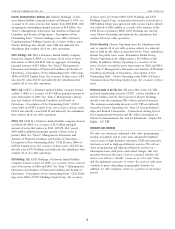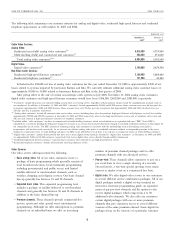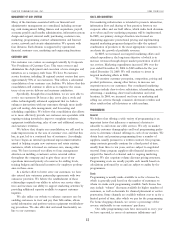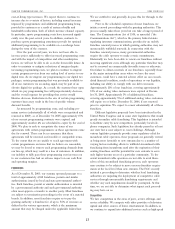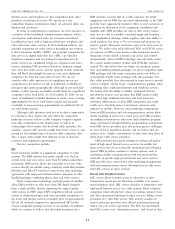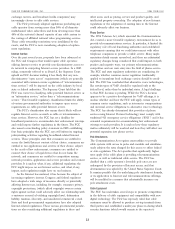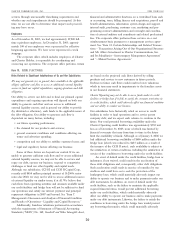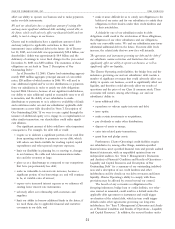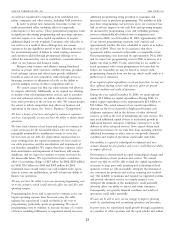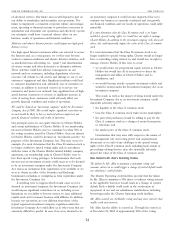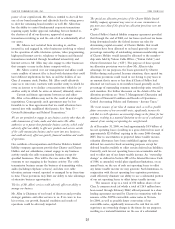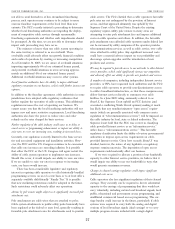Charter 2005 Annual Report Download - page 28
Download and view the complete annual report
Please find page 28 of the 2005 Charter annual report below. You can navigate through the pages in the report by either clicking on the pages listed below, or by using the keyword search tool below to find specific information within the annual report.
CHARTER COMMUNICATIONS, INC. 2005 FORM 10-K
exchange carriers, and broadcast/media companies) may other areas, such as pricing, service and product quality, and
increasingly choose to offer cable services. intellectual property ownership. The adoption of new Internet
The FCC previously adopted regulations precluding any regulations or the adaptation of existing laws to the Internet
cable operator from serving more than 30% of all domestic could adversely affect our business.
multichannel video subscribers and from devoting more than Phone Service
40% of the activated channel capacity of any cable system to The 1996 Telecom Act, which amended the Communications
the carriage of affiliated national video programming services. Act, created a more favorable regulatory environment for us to
These cable ownership restrictions were invalidated by the provide telecommunications services. In particular, it limited the
courts, and the FCC is now considering adoption of replace- regulatory role of local franchising authorities and established
ment regulations. requirements ensuring that we could interconnect with other
Internet Service telephone companies to provide a viable service. Many imple-
Over the past several years, proposals have been advanced at mentation details remain unresolved, and there are substantial
the FCC and Congress that would require cable operators regulatory changes being considered that could impact, in both
offering Internet service to provide non-discriminatory access to positive and negative ways, our primary telecommunications
its network to competing Internet service providers. In a 2005 competitors and our own entry into the field of phone service.
ruling, commonly referred to as Brand X, the Supreme Court The FCC and state regulatory authorities are considering, for
upheld an FCC decision making it less likely that any non- example, whether common carrier regulation traditionally
discriminatory ‘‘open access’’ requirements (which are generally applied to incumbent local exchange carriers should be modi-
associated with common carrier regulation of ‘‘telecommunica- fied. The FCC has concluded that alternative voice technologies,
tions services’’) will be imposed on the cable industry by local, like certain types of VoIP, should be regulated only at the
state or federal authorities. The Supreme Court held that the federal level, rather than by individual states. A legal challenge
FCC was correct in classifying cable-provided Internet service as to that FCC decision is pending. While the FCC’s decision
an ‘‘information service,’’ rather than a ‘‘telecommunications appears to be a positive development for VoIP offerings, it is
service.’’ This favorable regulatory classification limits the ability unclear whether and how the FCC will apply certain types of
of various governmental authorities to impose open access common carrier regulations, such as intercarrier compensations
requirements on cable-provided Internet service. and universal service obligations to alternative voice technology.
The FCC’s classification also means that it likely will not The FCC has already determined that providers of phone
regulate Internet service as much as cable or telecommunica- services using Internet Protocol technology must comply with
tions services. However, the FCC has set a deadline for traditional 911 emergency service obligations (‘‘E911’’) and it has
broadband providers to accommodate law enforcement wiretaps extended requirements for accommodating law enforcement
and could impose further regulations in the future. The FCC wiretaps to such providers. It is unclear how these regulatory
also issued a non-binding policy statement in 2005 establishing matters ultimately will be resolved and how they will affect our
four basic principles that the FCC says will inform its ongoing potential expansion into phone service.
policymaking activities regarding broadband-related Internet Pole Attachments
services. Those principles state that consumers are entitled to The Communications Act requires most utilities to provide
access the lawful Internet content of their choice, consumers are cable systems with access to poles and conduits and simultane-
entitled to run applications and services of their choice, subject ously subjects the rates charged for this access to either federal
to the needs of law enforcement, consumers are entitled to or state regulation. The Act specifies that significantly higher
connect their choice of legal devices that do not harm the rates apply if the cable plant is providing telecommunications
network, and consumers are entitled to competition among service, as well as traditional cable service. The FCC has
network providers, application and service providers and content clarified that a cable operator’s favorable pole rates are not
providers. It is unclear what, if any, additional regulations the endangered by the provision of Internet access, and that
FCC might impose on our Internet service, and what, if any, determination was upheld by the United States Supreme Court.
impact, such regulations might have on our business. It remains possible that the underlying pole attachment formula,
As the Internet has matured, it has become the subject of or its application to Internet and telecommunications offerings,
increasing regulatory interest. Congress and federal regulators will be modified in a manner that substantially increases our
have adopted a wide range of measures directly or potentially pole attachment costs.
affecting Internet use, including, for example, consumer privacy,
copyright protections, (which afford copyright owners certain Cable Equipment
rights against us that could adversely affect our relationship with The FCC has undertaken several steps to promote competition
a customer accused of violating copyright laws), defamation in the delivery of cable equipment and compatibility with new
liability, taxation, obscenity, and unsolicited commercial e-mail. digital technology. The FCC has expressly ruled that cable
State and local governmental organizations have also adopted customers must be allowed to purchase set-top terminals from
Internet-related regulations. These various governmental jurisdic- third parties and established a multi-year phase-in during which
tions are also considering additional regulations in these and security functions (which would remain in the operator’s
18


